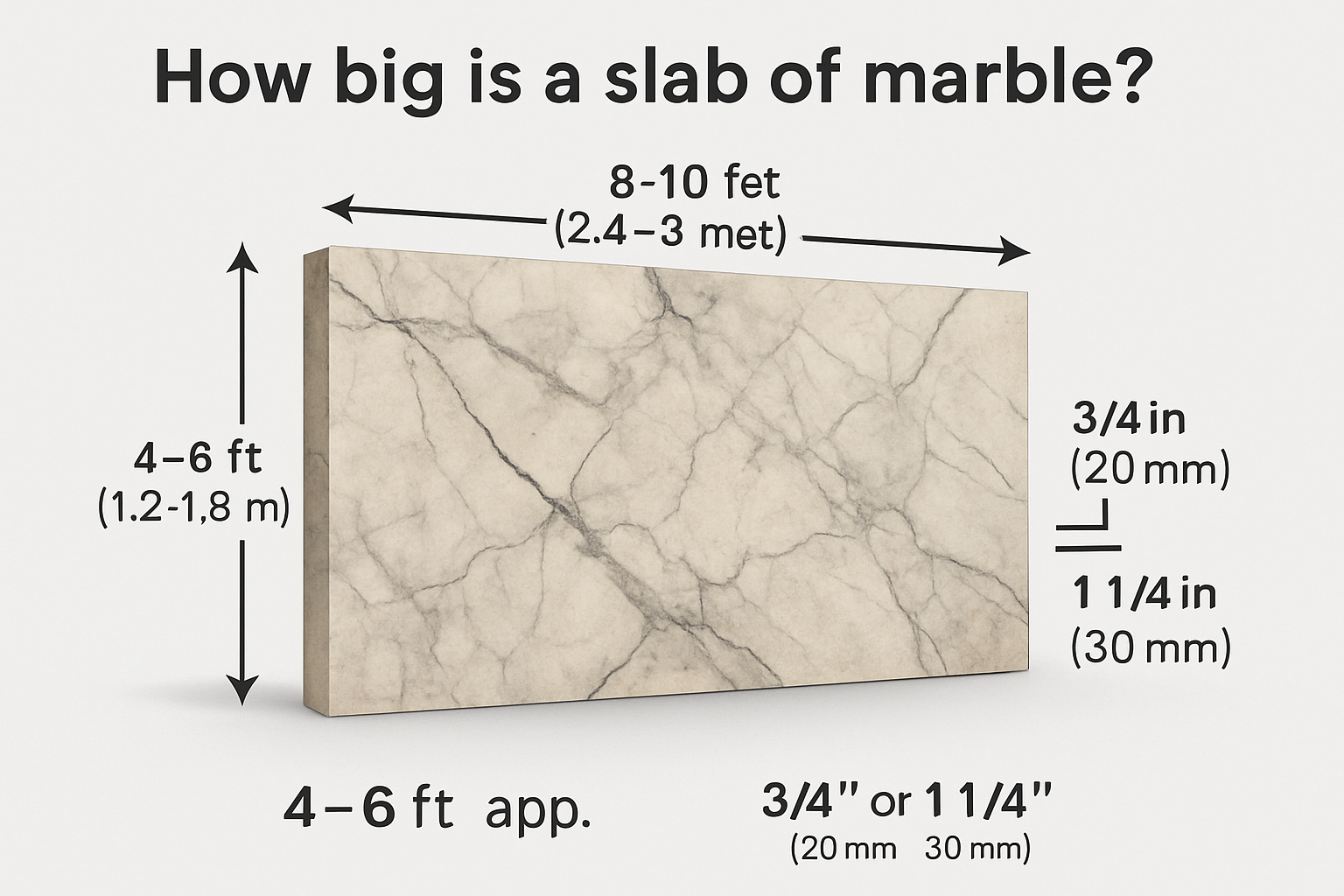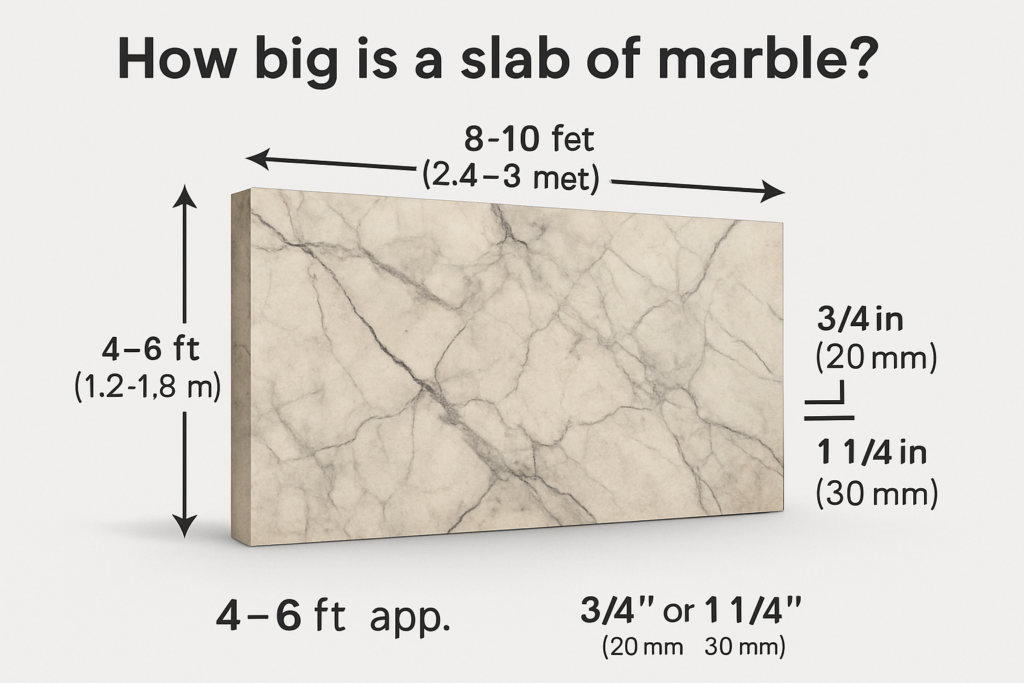
Marble slab is an elegant and timeless choice for construction and interior design, often seen in luxurious kitchen countertops, bathrooms, flooring
Marble slab are an elegant and timeless choice for construction and interior design, often seen in luxurious kitchen countertops, bathrooms, flooring, and wall cladding. But one of the most common questions people ask is: How big is a slab of marble?
Whether you’re planning a remodeling project or coordinating with a fabricator, understanding standard slab sizes is essential. While the dimensions of granite slabs and marble slabs often overlap, marble’s fragility and veining patterns may influence size choices and application strategy.
This article explores standard marble slab sizes, thicknesses, weight, transport factors, and how it compares to granite—offering clarity for homeowners, contractors, and designers.

Standard Dimensions of Marble Slabs
Marble slabs are typically cut from large stone blocks extracted from quarries. These blocks are sliced into thin, flat panels using gang saws or wire saws.
Average Slab Dimensions
While dimensions vary based on the quarry and country of origin, most marble slabs fall within these ranges:
- Length: 8 to 10 feet (approx. 2.4 to 3 meters)
- Height: 4 to 6 feet (approx. 1.2 to 1.8 meters)
- Thickness: Most commonly 20mm (3/4 inch) or 30mm (1 1/4 inch)
For comparison, granite slabs are often available in slightly larger formats due to their greater structural integrity. This makes granite more adaptable for expansive surfaces like large kitchen islands or full-height walls.
Learn more about the properties of marble slabs in this related article:
👉 What Is a Marble Slab?
Super Jumbo and Custom Slabs
Some suppliers offer jumbo slabs or bookmatched sets, especially for dramatic marble designs or continuous wall installations.
- Super jumbo marble slabs may reach:
- Length: 130–140 inches (3.3–3.6 meters)
- Height: 75–80 inches (1.9–2 meters)
However, these slabs require specialized handling equipment and expertise for countertop installation or wall cladding due to their weight and brittleness.
How Heavy Is a Marble Slab?
Marble is dense—its weight depends on the thickness and volume of the slab.
Weight Estimates:
- 20mm (3/4″) thick marble slab weighs approx. 600–700 lbs (272–317 kg)
- 30mm (1-1/4″) thick slab can weigh 900–1,100 lbs (408–499 kg)
This substantial weight highlights why precision during installation is critical for both safety and aesthetics. Read:
👉 Why Is Precision Important in Granite Facade Installation?
Comparing Marble Slab Sizes to Granite
While marble and granite slabs can be similar in dimensions, their material properties influence how they’re handled and used:
| Property | Marble | Granite |
|---|---|---|
| Maximum slab size | Slightly smaller | Larger (less brittle) |
| Weight (per sq. ft.) | ~18-20 lbs (20mm) | ~19-22 lbs (20mm) |
| Application flexibility | More decorative | More structural |
| Color variety | Soft whites, beiges, greys | Bold blacks, blues, reds |
Marble is typically selected for appearance; granite for performance—especially where long spans or outdoor exposure are involved.
Applications Based on Slab Size
For Kitchen Countertops
Most kitchen countertops require slabs at least 8–10 feet long to cover islands or L-shapes without seams. Granite is often preferred here for its scratch resistance, but marble brings unmatched aesthetic appeal.
For Bathroom Walls and Floors
Standard-sized marble slabs make excellent backsplashes, shower walls, or accent flooring when cut and laid with care. Matching granite slab colors can be used on adjacent floors or vanities for contrast.
For Commercial Spaces
Large-format marble slabs can be used in lobbies, reception counters, and wall paneling to make bold design statements. However, engineered support is crucial due to weight.
Customization and Fabrication Considerations
Slabs can be custom cut to meet architectural requirements. Fabricators work with CAD software and CNC machines to ensure:
- Seamless countertop installation
- Integrated sink cut-outs
- Bookmatched or vein-matched panel layouts
- Edge profiling for visual enhancement
Whether using natural granite or marble, accurate sizing is key to minimizing waste and ensuring design success.
Installation and Handling Best Practices
Due to the large size and weight of marble slabs:
- Transportation requires A-frames or secure stone racks
- Slabs should be carried vertically to prevent cracking
- Professional installers use suction lifters or vacuum lifters to avoid damage
For installation on facades or cladding systems, refer to:
👉 When Is the Ideal Stage to Apply Granite Cladding During Construction?
Cleaning and Maintenance Based on Size
Larger slabs mean fewer grout lines—but proper maintenance remains vital.
Cleaning Tips:
- Always clean granite or marble with pH-neutral solutions
- Avoid acidic cleaners that could etch polished surfaces
- Seal every 6–12 months depending on traffic and exposure
For surface damage or cracks in large slabs, granite countertop repair techniques can be adapted to restore integrity and finish.
Design Ideas and Aesthetic Considerations
Visual Impact
Large slabs with uninterrupted veining add a dramatic, upscale look—ideal for:
- Waterfall islands
- Full-height shower walls
- Fireplace surrounds
- Floating staircase cladding
Pairing With Other Materials
- Use artificial granite with marble for cost-effective contrast
- Mix polished marble walls with honed granite countertops for textural depth
- Combine light marble and dark granite for balanced tonal contrast
Conclusion: Choose the Right Marble Slab Size for Your Project
So, how big is a slab of marble? Most range from 8 to 10 feet long and 4 to 6 feet high, with standard thicknesses of 20mm or 30mm. Larger or custom slabs are available, but they demand more planning, support, and precision.
Understanding slab sizes ensures better design decisions, accurate cost estimation, and successful execution—especially when paired strategically with granite, one of the most durable and versatile natural stones available.

